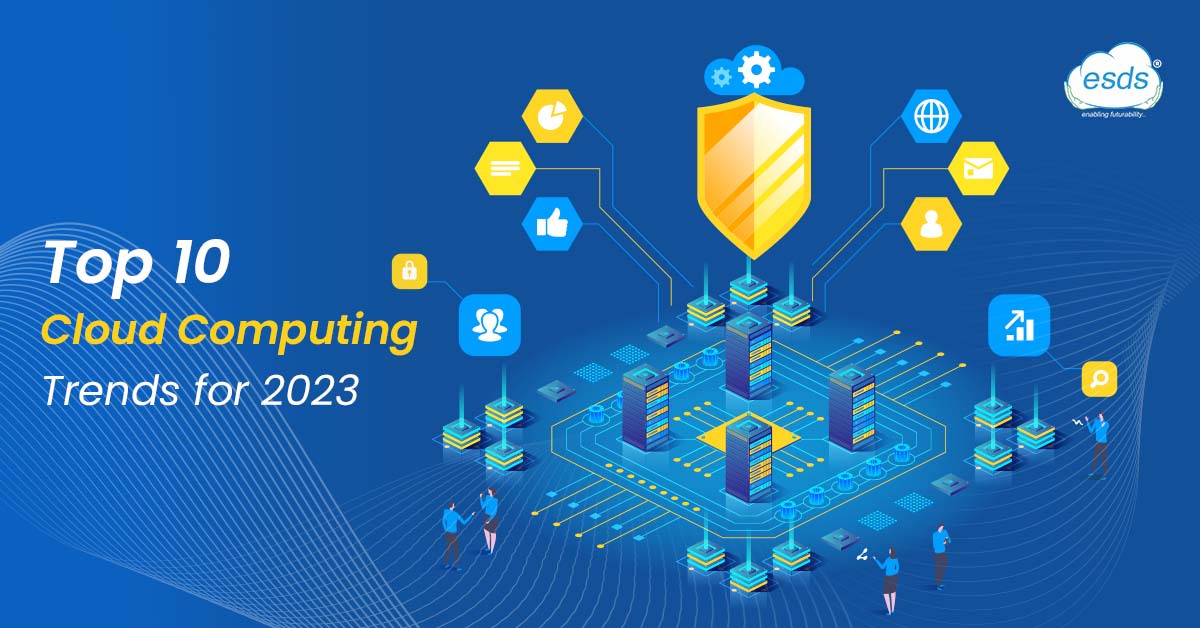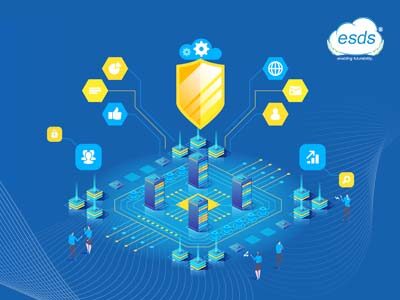Top 10 Cloud Computing Trends for 2023

The market for public cloud services in India will grow 29.6% from 2021 to $7.3 billion by the end of 2022, predicts Gartner. Since remote working options were made possible by the pandemic of the past two years, every firm was compelled to embrace cloud platforms like never before. It paved the path for businesses to integrate cloud technologies into their operations for more flexibility in such turbulent times. Every corporation wanting business continuity, cost reduction, and enhanced future scalability must now use cloud computing.
The following are some of the biggest cloud computing trends for 2023

1. Multi and Hybrid Cloud Deployment
According to Gartner’s forecasts, more than 75% of midsize and large enterprises must have adopted a multi-cloud or hybrid IT strategy by the end of 2021. Over 90% of businesses will choose a hybrid cloud solution architecture in 2021, according to the IDC analysis, which combines on-premise, dedicated private clouds, several public clouds, and legacy platforms.
The reason is that businesses now understand that data management involves combining a variety of appropriate cloud deployment strategies rather than relying solely on one cloud platform or architecture. A lot of businesses will want more than one vendor for hybrid or multi-cloud deployment in 2023 to get the most out of each solution. A hybrid cloud architecture offers a combination of public and private clouds dedicated to a specific company whose data is their key business driver, such as insurance, banks, etc. Consequently, Multi and Hybrid Cloud Deployment will be among the top cloud computing trends in 2023 and the years to come.
2. Edge Computing
Here is a brief explanation of edge computing in case you’re unclear. In edge computing, data is stored, processed, and analyzed geographically closer to its source. Edge computing applications that process and analyze data at the network’s edge are expanding as a result of the increasing use of 5G. Greater privacy, security, speed, and efficiency are ensured by edge computing. Edge computing also allows companies to streamline operations, automate procedures, boost performance, and, most importantly, accelerate their digital transformation.
Edge computing will eventually be at the center of every cloud strategy, making it the top cloud computing trend for 2023. By 2024, most cloud platforms will feature a sizable number of distributed cloud services that operate at the edge, according to Gartner research. According to IDC projections, the global market for edge computing will expand by 12.5% a year from 2024 and reach $250 billion.
3. Cloud-Native Applications
Cloud-native apps are increasingly being adopted by a growing number of businesses. These programs are designed to withstand significant changes while maintaining resilience. Additionally, they make it possible for companies to create, launch and manage cloud apps considerably more quickly.
Cloud-native apps provide businesses the freedom to continuously change, add features, and enhance them for better user and customer experiences. Additionally, managing cloud-native apps is simple and involves fewer resources and vendor participation. The cost of IT has significantly decreased as a result of infrastructure standardization. Organizations may improve their agility, adaptability, and customer focus by using cloud-native apps. As a result, they are a hub for the modern IT industry. This is supported by a recent poll by Capgemini, which found that 32% of all new enterprise IT apps are cloud-native.
4. Cloud Security and Resilience
Organizations and companies face a new range of cyber security threats when they migrate to the cloud. Cloud migration offers many benefits, efficiencies, and conveniences but presents several security risks. Further, the increasing pile of legislation around data storage and use means that businesses are at risk of being fined or (even worse) losing the trust of their customers. Because of it, investing in cyber security and building resilience against everything from data loss to the impact of a pandemic on global business will become a priority increasingly during the coming year.
As a result, during the upcoming year, investing in cyber security and developing resilience against everything from data loss to the effects of a pandemic on international trade will become increasingly important and a big cloud computing trend.
The emphasis will likely be on finding novel and cost-effective ways to maintain cyber security in order to get the greatest “bang for the buck,” even while many businesses appear to be cutting costs in the wake of a predicted economic crisis. In 2023, this will expand the usage of managed “security-as-a-service” providers and AI and predictive technology to detect risks before they cause issues.
5. The AI and ML-Powered Cloud
Due to the limited resources available to businesses to develop their own AI infrastructure, cloud services for artificial intelligence (AI) and machine learning (ML) are offered. Large amounts of computational power and storage space are needed for data collection and algorithm training, and renting these resources as a service is typically more cost-effective. More and more, cloud service providers use AI internally for a variety of purposes. This involves running the enormous, dispersed networks required to supply storage resources to their clients, controlling the cooling and electricity systems in data centers, and providing the cyber security tools that protect their data.
6. Low-code and no-code cloud services
People are interested in tools and platforms that allow anyone to create applications and use data to solve problems without writing computer code. This group of low-code and no-code solutions consists of programs for creating websites, web applications, and virtually any other type of digital product a business wants. As a result, the entry barriers for companies looking to use AI and ML have been dramatically lowered because of the availability of low-code and no-code solutions hence making it a cloud computing trend of 2023.
7. The Evolution of Cloud Gaming
We now consume movies, TV shows, and music using streaming services like Netflix and Spotify, thanks to the cloud. Streaming video gaming is taking a little longer to gain traction, but Microsoft, Sony, Nvidia, and Amazon are all offering it. It has been challenging sailing, however – after spending millions of dollars developing Stadia, Google retired it this year after it failed to meet commercial expectations. One of the problems is the networks themselves – streaming video games clearly requires higher bandwidth than music or videos, so it is only possible for those of us who have decent, high-speed internet access, which is still a small percentage of the population.
However, this issue should eventually be resolved with the introduction of 5G and other extremely fast networking technologies, and 2023 might be the year that cloud gaming will become a significant industry. According to Google, the technology that underpins Stadia will continue to exist as the foundation of a B2B game streaming service that is currently being developed and will enable game developers to offer streaming features directly to their consumers. If cloud gaming turns out to be the “killer app” for 5G in the same way that streaming video and music were for 4G and 3G, respectively, then 2023 might be the year that everything starts to come together.
8. Blockchain
Blockchain technology provides a tamper-proof digital ledger that can record data without depending on a centralized authority. Blockchain emerged as a game-changer but faces scalability issues, particularly in managing and storing large amounts of data. Nevertheless, businesses will continue to push the boundaries of blockchain in 2023 because it is a perfect fit. One of the biggest trends in cloud computing could be the deployment of blockchains and the parts that make them up.
9. Internet of Things
IoT is one of the most well-known next trends in cloud computing. It is a technology that maintains connections between computers, servers, and networks. IoT functions as a mediator, ensuring successful communication and assisting in data collection from remote devices for efficient operations. It also provides assistance in various other ways, such as resolving warnings and supporting the security protocols established by businesses to create a safer cloud environment.
10. Kubernetes
To support the constantly expanding ecosystem, Kubernetes also offers automation to those working on cloud networks as it moves closer to the automation world. It is an extensible, open-source platform that runs your applications from a single source while centrally managing the services and workloads.
Summing up
Since the epidemic began, the tsunami of cloud adoption has been at its height and will continue to soar in 2023. Organizations can expand their cloud capabilities and upgrade and upscale their digital products by using the cloud. The “purpose-fit for the cloud” method has already been replaced by the “cloud-first” strategy by end of 2022. In 2023, businesses’ passion for innovation and continual learning will be a major factor in mastering the cloud solution. These patterns in cloud computing will change as cloud use rises, just like anything else. Your company will be able to use the greatest cloud solution on the market if you stay on top of these trends.
- Top 5 Data Center Trends for 2024 - October 11, 2023
- Top 15 Cloud Computing Trends 2024 - October 4, 2023
- What is Infrastructure Monitoring and Why Infrastructure Monitoring Tool is Important for Your Business? - September 20, 2023
